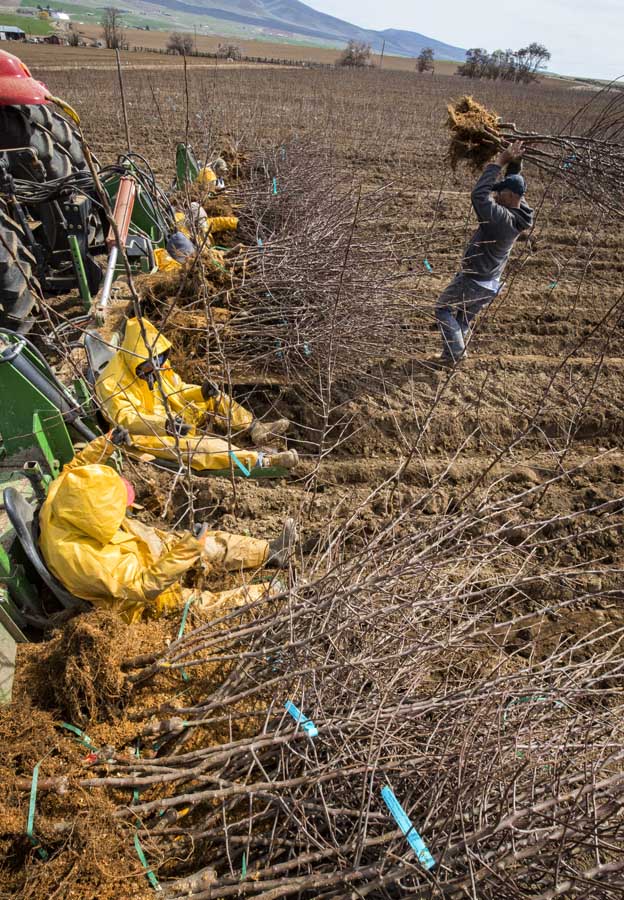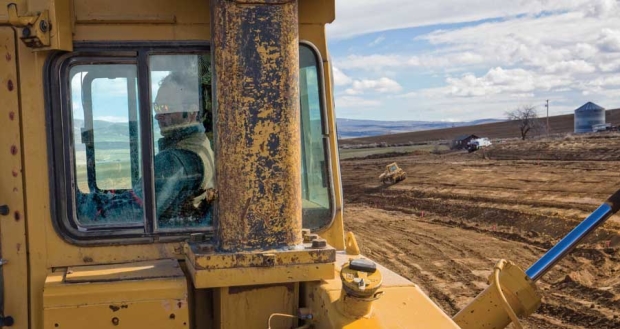
Stan Klabenes operates a large bulldozer on March 3, 2016, across the slope of a new cooling and frost control pond at a future orchard owned by Washington Fruit and Produce Co. near Kittitas, Washington. Klabenes works for Selland Construction, Inc., based in Wenatchee.(TJ Mullinax/Good Fruit Grower)
There’s a lot to consider when replanting an orchard: rootstock, scion, trellis type and irrigation method, to name a few. Soil type is another, and it’s particularly important when matching specific rootstocks and scions to locations.
So imagine the complexities involved when you’re planting hundreds of thousands of trees across several sites.
That’s the case for Washington Fruit and Produce Co., which is removing some underperforming orchards and replacing them with more desirable cultivars, as well as filling in existing orchards.

Dan Plath
Orchard manager Dan Plath calls replanting a difficult puzzle, because, like many companies, Washington Fruit orders trees well in advance of planting. The company placed its tree orders with nurseries in 2014 without knowing exactly where any of those trees would be planted.
“Now, as we get to 2016, we’re looking at the decisions we made in 2014 in terms of variety selection and how can we best match to the available sites, which is kind of backwards,” he said. “Ideally, you have the site and you go out and get the right variety to plant on it, but it’s just the way it works when you order trees, because the demand for trees far outpaces supply.”
Low prices in 2014 prompted the company to accelerate plans to renovate some older orchards — that year saw an oversupply of Red Delicious, Golden Delicious and Granny Smith, and the company also saw an increase in the number of Fujis and Galas that didn’t meet target size — but the central motivation is to stay current.
“We’re constantly renovating older orchards to stay modern on genetics,” he said. “We’re maybe doing a little bit less expansion than we normally would had we not gone through the 2014 crop with those prices. The same thing very well could happen in 2016.”
A nutrient analysis at each of the five sites helps to determine the fertilizer program for the first year, which varies by baseline. “Deficiencies aren’t really a problem because you can fix it. But say the previous site used a lot of manure or particular fertilizer in certain areas of the farm, and you’re starting really hot, with high levels. That’s where it causes you to change your plan a little bit more,” Plath said.
Standard practice at any replant or planting site is for workers to rip the soil in two different directions, trying to dig at least 3 feet beneath the soil surface. They then go back and disk the soil to clean out any remaining debris, taking as many as four passes depending on what was previously planted there.
The company uses a three-row tree planter that has big shanks opening up the ground to plant the tree. It requires a crew of six, plus the driver and another crew bringing trees to the planter from the trailers.

A three-row tree planter is used in Kittitas, Wash., on April 6, 2016 by Washington Fruit & Produce Co. The planter cuts three furrows allowing workers to place trees or bench grafts into the soil using GPS precision. The planter can help the crew plant between eight to 10 acres a day. (TJ Mullinax/Good Fruit Grower)
“If there’s a lot of organic matter left in the soil, big chunks of grass or whatever it might be, it makes the tree planter very inefficient,” he said.
Here’s a rundown of how Washington Fruit approaches planting and replanting at multiple sites in one season.
To fumigate or not to fumigate?
Outside the small town of Plymouth, Washington, overlooking the Columbia River, Washington Fruit is pushing out an old, 80-acre block of Fuji and Gala apple trees that weren’t producing target fruit size, which is anywhere from 64 to 100.
The site sits on sandy loam, and with plans to replant there, Plath said fumigating the site was an easy call.
He recounted the advice of Washington State University Extension educator Tim Smith about fumigation: “Any time you are going from something with bark to apples, you need to fumigate.

Joe Dobson operates a large bulldozerin Kittitas, Wash., on March 3, 2016 for Washington Fruit & Produce Company. The project site for the new orchard includes the land stretching off in the distance. (TJ Mullinax/Good Fruit Grower)
If there have been trees on the ground before, then we’re going to fumigate,” he said. If there haven’t been trees, then Washington Fruit tests the soil for nematodes and, depending on those levels, will make a determination about fumigating.
At this site, the company is planting Cripps Pink on Geneva 41 rootstock. In addition, the Plymouth site is where the company has elected to invest in cherries, because it’s one of the earliest sites to harvest with higher returns to the farm.
Varieties being planted are Tieton cherries on Gisela 12 and Tieton and Santina cherries on Gisela 6.
Up the highway near Zillah, the company elected to fumigate 60 purchased acres that had not been planted in tree fruit for about 15 years.
“It was one that was kind of questionable, whether we fumigate it or not,” Plath said. “But if you’re going to invest $40,000 to $50,000 an acre, by the time you’ve brought it up to production where you can go cash-flow positive on it, there’s no reason to skimp on the last $700 an acre.”
Also on sandy loam, the land sits in the Roza Irrigation District, which has a junior water right and faces water curtailments in drought years.
That was a consideration in the decision to plant Grannys on Malling 9.337 and Cripps Pink on M9.337 and G.41. “You can farm those without overhead cooling,” he said.
Higher elevation
Overall, a large quantity of the trees ordered are on M9.337, followed by M.106, which has been popular for Reds. “We were planting Reds.
Then we saw what happens when the industry has 50 million boxes of Reds, so our secondary variety selection for 106 is Honeycrisp,” he said.
That’s the target variety for two sites at higher elevations west and north of Yakima that are better suited for Honeycrisp. Both have heavier soils and were fumigated all or in part because trees had been planted there before.
North of Yakima, most of the 120 acres had been planted in alfalfa, though one chunk had been an orchard, since abandoned. The site is largely being planted to Honeycrisp on multiple rootstocks: Budagovsky 9, Bud.118, M.106, G.11 and M9.337.
Orchard manager Nick Plath, who is Dan’s cousin, said the irrigation had been shut down last year, due to drought, but there was a section of orchard that needed to be fumigated. Around mid-October, irrigators received water again and he said he scrambled to water the section that needed to be fumigated.
“I watered for a few weeks, then ripped it and disked it and had just enough moisture to fumigate it later in the fall, making it possible to plant this spring,” he said.
West of Yakima, the company planted about 100 acres of Honeycrisp on M.106 last year, and is planting another 28 acres of the same this year.
Royal City and Othello

Adrian Calderon installs anchors into the ground to support V-trellis systems used on new Fuji plantings on M9.337 rootstock north at a Washington Fruit & Produce Co., ranch north of Royal City, Wash., on March 29, 2016. (TJ Mullinax/Good Fruit Grower)
Washington Fruit may be taking out Galas and Fujis at one farm, but the company is planting them at orchards near Royal City. The company bought this land, subject to a lease, about eight years ago, and took over farming parts of it as the leases expired.
The planting this year is the last 55 acres from that purchase and the third phase of planting there. The orchards sit in sandy loam, where Galas and Fujis have done well, Dan Plath said.
Nearby in Othello, Washington Fruit planted Reds two years ago. The company has already grafted those over to Honeycrisp and plans to plant Honeycrisp on M.106 on an additional 6 acres purchased from a neighbor.
“Young orchards are funny, in that some varieties you get the best fruit that you’re going to get from the first couple of crops, like Galas, Fujis, Cripps Pink. You get the biggest, reddest fruit from the first couple of crops,” Plath said. “Other varieties, you get the worst fruit the first couple of crops, and Reds is one of them. So we looked at it: We have too many Reds and we have these producing orchards that are in good position, and we can try something else.”
Trellis
Washington Fruit uses a standard trellis across most of its apple orchards — a V-trellis with seven wires and a 10-foot middle — though there are changes in tree spacing by variety. For instance, Cripps Pink are 2-by-10, while Grannys are 1.75-by-10. Honeycrisp trees on M.106 and Bud.118 are on a vertical trellis and planted not as densely because the trees need a little more space with a more vigorous rootstock, he said.
“We think row spacing is more important than spacing between trees down the row,” he said. “The trees closer together will have higher yield, but further down the road, I think those yields will pretty well even out.”
Branches are formally trained onto the wires, setting the fruiting wall up for mechanization, should it occur. “That’s a bonus. We didn’t design it for mechanization,” Plath said. “We plant the orchards we think are, horticulturally, the right thing to do, and if mechanization comes along and works for it, great.” •
– by Shannon Dininny






Leave A Comment